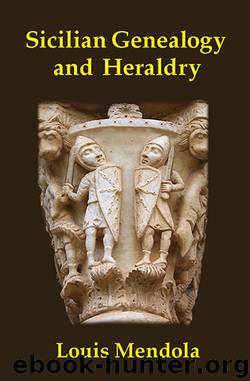Sicilian Genealogy and Heraldry by Louis Mendola

Author:Louis Mendola
Language: eng
Format: epub
Publisher: Trinacria Editions LLC
Published: 2013-03-15T16:00:00+00:00
Proskenion
Let’s set the stage by reviewing a few relevant principles, some quite elementary.
The field of genealogy has its own terminology. There are agnates (kin related via lines of ascent and descent through males), cognates (kin related by ascent or descent through females as well as males) and collaterals (siblings and cousins). Descents are patrilineal, matrilineal or both (ambilineal). There is consanguinity (kinship by blood measured in degrees of descent from a common ancestor) and affinity (kinship “in law” through marriage or adoption). There are progenitors (defined as the earliest lineal ancestor), nepots (grandchildren, nieces, nephews) and the occasional eponymous (the first forebear to use a certain surname). Essentially uniform today, historical kinship systems and marriage practices varied widely from one society to another; in Sicily we’ll focus on the European incarnation, shaped by Roman law and, to a lesser extent, Germanic law.
What do genealogists do? Describing the work of advertising agents, William Bernbach posited that “our job is to bring the dead facts to life.” That’s a fair description of the genealogist’s task. Today the greater part of the research undertaken to construct genealogies is conducted (or commissioned) by those interested in their own ancestry, and no two genealogical research projects are identical. But the usefulness of genealogy as a science doesn’t end there, and the field is less esoteric than its popular image would have us believe.
As we’ve mentioned, genealogy encompasses numerous disciplines. Onomastic and genetic identification are aided by genealogical science, and vice versa. Surnames and DNA could be said to be the most conspicuous “hereditaments” because these “birthrights” are everyday things.
Much of this has to do with heredity and inheritance; both play greater social roles than many of us acknowledge consciously. In Italy, parents are legally obligated to will their estates to their children, in equal parts, male or female, matrimonial or natural, and this is common practice even in some countries where no such law exists. Many parents assist their children materially into adulthood, well past the age of eighteen; here too, we see a hereditary principle at work. No, aristocrats and plutocrats are not the only ones who appreciate heredity and kinship, and thus genealogy.
In the “general” history that chronicles major events, pedigrees showing familial relationships are important in identifying dynasties and their connections to each other. Whether the student of history seeks to better understand Sicily’s War of the Vespers or England’s War of the Roses, the protagonists’ pedigrees provide clarity – claims to crown rule were based on heredity and virtually all states were monarchies. That, however, didn’t end with the Middle Ages. During the First World War, several of the crowned heads of Europe’s warring empires and kingdoms were cousins descended from Queen Victoria, who died in 1901. The actions of these cousins shaped international events, led to the dissolution of a few monarchies (Germany, Russia, Austria, Turkey, Montenegro) and spawned a bloody revolution. The fact that a few of the kings were part of one large, extended family doesn’t seem to have helped matters.
Download
This site does not store any files on its server. We only index and link to content provided by other sites. Please contact the content providers to delete copyright contents if any and email us, we'll remove relevant links or contents immediately.
| African-American Studies | Asian American Studies |
| Disabled | Ethnic Studies |
| Hispanic American Studies | LGBT |
| Minority Studies | Native American Studies |
Cecilia; Or, Memoirs of an Heiress — Volume 1 by Fanny Burney(31348)
Cecilia; Or, Memoirs of an Heiress — Volume 3 by Fanny Burney(30947)
Cecilia; Or, Memoirs of an Heiress — Volume 2 by Fanny Burney(30906)
The Great Music City by Andrea Baker(21568)
We're Going to Need More Wine by Gabrielle Union(18081)
Bombshells: Glamour Girls of a Lifetime by Sullivan Steve(13119)
Pimp by Iceberg Slim(12943)
All the Missing Girls by Megan Miranda(12771)
Fifty Shades Freed by E L James(12462)
Talking to Strangers by Malcolm Gladwell(11904)
Norse Mythology by Gaiman Neil(11900)
Crazy Rich Asians by Kevin Kwan(8367)
Mindhunter: Inside the FBI's Elite Serial Crime Unit by John E. Douglas & Mark Olshaker(7848)
The Lost Art of Listening by Michael P. Nichols(6481)
Enlightenment Now: The Case for Reason, Science, Humanism, and Progress by Steven Pinker(6414)
Bad Blood by John Carreyrou(5779)
The Four Agreements by Don Miguel Ruiz(5529)
Weapons of Math Destruction by Cathy O'Neil(5046)
We Need to Talk by Celeste Headlee(4879)
